
HOME
INTRO
SYMBOLS
ALMANAC
ECONOMY
GEOGRAPHY
STATE MAPS
PEOPLE
FORUM
NEWS
COOL SCHOOLS
STATE QUIZ
STATE LINKS
BOOK STORE
MARKETPLACE
GUESTBOOK
CONTACT US


You may double left-click on a word on this page to retrieve its definition. Tweet Follow
Tennessee State Evergreen Tree
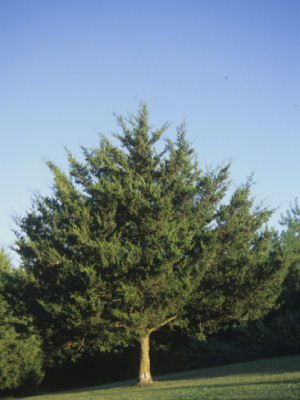
Tennessee State Evergreen Tree: Eastern Red Cedar
Photograph
Each of the fifty states has designated a tree to serve as an official representative. Only one state in the Union has adopted an official evergreen tree; Tennessee.
The approval of an official evergreen tree came easily in the Tennessee General Assembly. Approval also came quickly.
We think this had much to do with how the legislation was presented.
On January 12, 2012, Senator Mike Faulk introduced Senate Bill No. 2362 in the Tennessee State Senate. On January 18, the bill was referred to the Senate State and Local Government Committee.
At the same time, an identical bill, House Bill No. 2490 began its journey in the Tennessee House of Representatives.
These bills shared a common goal. They promoted and intended to procure for the eastern red cedar the position of official state evergreen tree of the State of Tennessee.
On January 31, 2012, Mike Faulk presented Senate Bill No. 2362 to the members of the State and Local Government Committee.
Many members of this committee would recognize that Tennessee has a state tree and it is the tulip poplar, but we've never designated an evergreen tree.
VideoTestimony
He extolled the numerous virtues of the bill, iterating the reasoning behind the proposal. After remarking that the eastern red cedar was found growing throughout the state, Sen. Faulk went on to lay out a full range of qualifications commemorating the heritage of the Volunteer State.
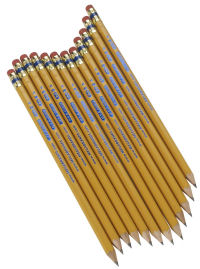
Cedar Pencils
Cedar trees are part of a unique habitat found in Tennessee. The eastern red cedars live on the periphery of cedar glades where soil is very shallow and the limestone bedrock is found near or breaking through the surface.
The tree is sacred to the Cherokee people providing sanctuary for the spirits of their ancestors. Known as the "Tree of Life" the eastern red cedar is often burned in purification rituals. One story associated with the tree is The Legend of the Cedar Tree. It teaches us to accept our blessings and bestow them with gratitude.
The eastern red cedar was one of the earliest landscape plantings used by settlers to the area and can be found on the grounds of Andrew Jackson's Hermitage in Nashville.
The trees also supported one of the earliest Tennessee forest industries, cedar pencils!
The state capitol in Nashville was built on Cedar Knob and the original name of the street at the foot of Cedar Knob at that time was named Cedar Street (now Charlotte Avenue).
The virtues of the eastern red cedar must have been abundantly clear to the members of the council. They lobbied for a vote on the measure before Sen. Faulk could finish his presentation.
There was no debate though Sen. Mark Norris did promise that the committee would definitely pass the bill if Sen. Faulk could clarify the status of the state fish, large-mouth or small-mouth bass.
Meanwhile, House Bill No.2490 was bouncing from committee to committee in the State House of Representatives.
On February 27, 2012, Senate Bill No. 2362 was substituted for House Bill No. 2490 and approved unanimously by the Tennessee House of Representatives.
SENATE BILL 2362
By Faulk
AN ACT to amend Tennessee Code Annotated, Title 4, Chapter 1, Part 3, to designate the eastern red cedar as the official state evergreen tree.
WHEREAS, there is no specific tree currently designated as the official state of Tennessee evergreen tree; and
WHEREAS, the eastern red cedar is indigenous to the entire state of Tennessee; and
WHEREAS, the tree was one of the earliest landscape trees used by early pioneers of the state of Tennessee such as Andrew Jackson at the Hermitage; and
WHEREAS, one of the earliest forest industries in the state of Tennessee was the cedar pencil industry; and
WHEREAS, the eastern red cedar is an integral part of an ecological niche called cedar glades; and
WHEREAS, the eastern red cedar is a sacred tree of the Cherokee peoples; and
WHEREAS, cedar knob was the original name of the land upon which the state capitol was built in Nashville; and
WHEREAS, Cedar Street (now Charlotte Avenue) was the name of the street at the foot of the state capitol in Nashville at the time of its construction; now, therefore
BE IT ENACTED BY THE GENERAL ASSEMBLY OF THE STATE OF TENNESSEE:
SECTION 1. Tennessee Code Annotated, Title 4, Chapter 1, Part 3, is amended by adding the following language as a new, appropriately designated section:
4-1-3 . The eastern red cedar, Juniperus virginiana, is designated as the official state evergreen tree.
SECTION 2. This act shall take effect upon becoming a law, the public welfare requiring it.
Without debate or controversy, the eastern red cedar was adopted as the official state evergreen tree of Tennessee when Governor Philip Norman "Phil" Bredesen, Jr. signed Senate Bill No. 2362 on March 13, 2012. The law went into effect on March 22, 2012.
Tennessee Law
The following information was excerpted from the Tennessee Code, Title 99, Chapter 99, Section 99.
Title 4 State Government
Chapter 1 General Provisions
Part 3 State Symbols
Tenn. Code Ann. § 4-1-332 (2016)
4-1-332. State evergreen tree.
The eastern red cedar, Juniperus virginiana, is designated as the official state evergreen tree.
HISTORY: Acts 2012, ch. 567, § 1.
Sources...
Christine. "All About the Eastern Red Cedar." The National Gardening Association. The National Gardening Association, 23 Nov. 2011. Web. 23 Nov. 2016.
Faulk, Mike. The State of Tennessee. Tennessee General Assembly. Senate Bill No. 2362
"Senate State and Local Government Committee Hearing." Tennessee General Assembly. State of Tennessee, 31 Jan. 2012. Web. 22 Nov. 2016.
"Tenn. Code Ann. § 4-1-332 (2016)." Tennessee Code Unannotated. LexisNexis©, a Division of Reed Elsevier Inc., n.d. Web. 23 Nov. 2014.
"The Traditional Belief System." The Cherokee Nation. The Cherokee Nation, n.d. Web. 21 Nov. 2016.
Additional Information
Pencil trees: Article by Dr. Bob Colyer.
All About the Eastern Red Cedar: National Gardening Association.
Juniperus virginiana: Eastern red cedar description from the Lady Bird Johnson Wildflower Center, University of Texas at Austin.
Eastern Red Juniper :
Plant Guide from the United States Department of Agriculture (USDA), Natural Resources Conservation Service.
:
Plant Guide from the United States Department of Agriculture (USDA), Natural Resources Conservation Service.
Juniperus virginiana L. (eastern red cedar): USDA, NRCS. 2016. The PLANTS Database (http://plants.usda.gov). National Plant Data Center, Baton Rouge, LA 70874-4490 USA.
Juniperus virginiana L.: Integrated Taxonomic Information System (ITIS).
Juniperus virginiana: Search for images of Juniperus virginiana with Google.
State trees: Complete list of official state trees from NETSTATE.COM.
More symbols & emblems: Complete list of official Tennessee state symbols from NETSTATE.COM.
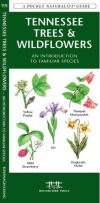
Tennessee Trees & Wildflowers: An Introduction to Familiar Species, by James Kavanagh. Illustration Count: 140. Size: 8.25" H x 3.5" W. Product Form: folded. Publisher: Waterford Press; 1st edition (April 1, 2010) A Pocket Naturalist Guide. Tennessee Trees & Wildflowers is the perfect pocket-sized, folding guide to familiar trees, shrubs and wildflowers.
This beautifully illustrated guide highlights over 140 familiar species and includes a map featuring prominent state-wide botanical sanctuaries.
Laminated for durability, this handy guide is a great source of portable information and ideal for field use by novices and experts alike.
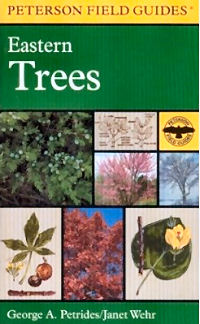
A Field Guide to Eastern Trees (Peterson Field Guides), by George A. Petrides. 448 pages. Publisher: Houghton Mifflin Harcourt (July 15, 1998) This field guide features detailed descriptions of 455 species of trees native to eastern North America, including the Midwest and the South.
The 48 color plates, 11 black-and-white plates, and 26 text drawings show distinctive details needed for identification. Color photographs and 266 color range maps accompany the species descriptions.
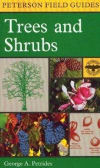
A Field Guide to Trees and Shrubs, by George A. Petrides. 464 pages. Houghton Mifflin Harcourt; Second Edition (September 6, 1973) All the wild trees, shrubs, and woody vines in the area north to Newfoundland, south to North Carolina and Tennessee, and west to the Dakotas and Kansas are described in detail.
Accounts of 646 species include shape and arrangement of leaves, height, color, bark texture, flowering season, and fruit. Clear, accurate drawings illustrate leaves, flowers, buds, tree silhouettes, and other characteristics.
A Field Guide to Eastern Forests: North America (Peterson Field Guide), by John C. Kricher. 512 pages. Publisher: Houghton Mifflin Harcourt (October 15, 1998) This field guide includes all the flora and fauna you're most likely to see in the forests of eastern North America. With 53 full-color plates and 80 color photos illustrating trees, birds, mammals, wildflowers, mushrooms, reptiles, amphibians, butterflies, moths, beetles, and other insects.
National Audubon Society Field Guide to North American Trees: Eastern Region, by Elbert Luther Little. 716 pages. Knopf; Chanticleer Press Ed edition (May 12, 1980) Tree peepers everywhere will enjoy these two guides which explore the incredible environment of our country's forests-including seasonal features, habitat, range, and lore. Nearly 700 species of trees are detailed in photographs of leaf shape, bark, flowers, fruit, and fall leaves -- all can be quickly accessed making this the ideal field guide for any time of year.
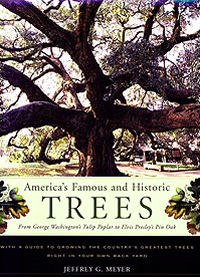
America's Famous and Historic Trees
by Jeffrey G. Meyer
America's Famous and Historic Trees: From George Washington's Tulip Poplar to Elvis Presley's Pin Oak (Hardcover)
by Jeffrey G. Meyer. America's Famous and Historic Trees tells the stories of various trees that Meyer and his cohorts rescued or propagated: oftentimes, when trees were going to be cut down, he and his workers headed off the bulldozers, rescuing the tree with their massive tree hoe. Other trees--like the Indian Marker Pecan in southeast Dallas--were propagated before they died.
Trees : National Champions (Hardcover)
by Barbara Bosworth. Bosworth captures the ineffable grace and dignity of trees with clarity and directness: the green ash that shades a Midwestern crossroads, the common pear that blooms in a Washington field, and the Florida strangler fig with its mass of entwining aerial roots. Her black and white photographs, panoramic views taken with an 8 x 10 camera, show the immensity of the largest species and the hidden triumphs of the smallest

